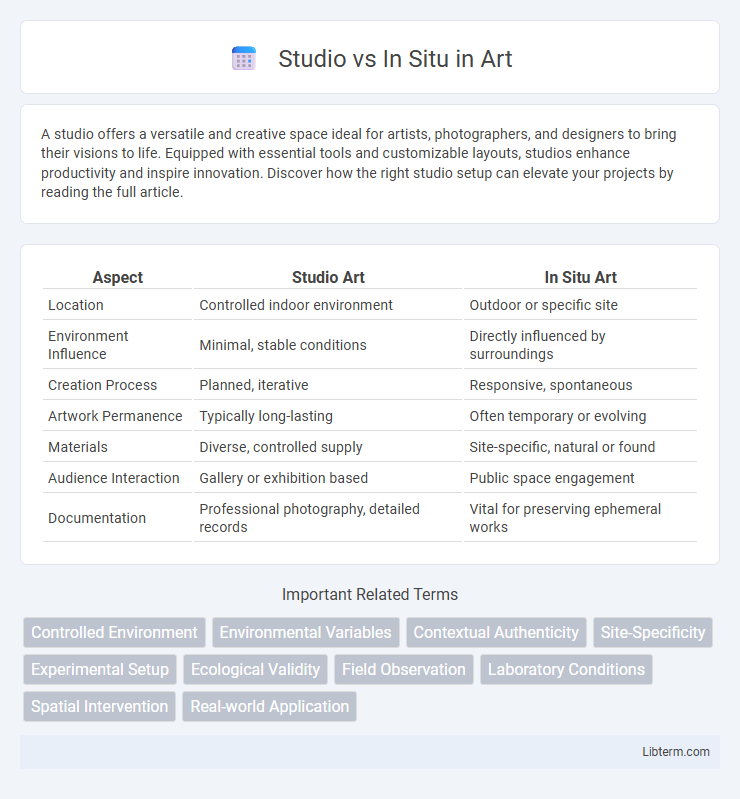A studio offers a versatile and creative space ideal for artists, photographers, and designers to bring their visions to life. Equipped with essential tools and customizable layouts, studios enhance productivity and inspire innovation. Discover how the right studio setup can elevate your projects by reading the full article.
Table of Comparison
| Aspect | Studio Art | In Situ Art |
|---|---|---|
| Location | Controlled indoor environment | Outdoor or specific site |
| Environment Influence | Minimal, stable conditions | Directly influenced by surroundings |
| Creation Process | Planned, iterative | Responsive, spontaneous |
| Artwork Permanence | Typically long-lasting | Often temporary or evolving |
| Materials | Diverse, controlled supply | Site-specific, natural or found |
| Audience Interaction | Gallery or exhibition based | Public space engagement |
| Documentation | Professional photography, detailed records | Vital for preserving ephemeral works |
Understanding Studio and In Situ: Key Definitions
Studio refers to a controlled environment where artists create, refine, and experiment with their work, often separated from the external context. In situ describes art created or installed directly within its intended location, emphasizing site-specific interaction and environmental influence. Understanding these definitions is crucial for appreciating how context impacts artistic expression and viewer experience.
Historical Context: Evolution of Studio and In Situ Practices
Studio and in situ practices evolved distinctly through art history, with studio work gaining prominence during the Renaissance as artists sought controlled environments for detailed composition and experimentation. In situ art traces back to prehistoric times with cave paintings, emphasizing direct interaction with the environment and immediate expression. The 20th century saw a resurgence of in situ methods in movements like Land Art, reflecting a shift towards site-specificity and environmental context.
Core Differences Between Studio and In Situ Approaches
Studio environments offer controlled settings where artists manipulate lighting, background, and composition to achieve precise visual outcomes, emphasizing technical perfection and repeatability. In situ approaches prioritize capturing subjects in their natural or original context, preserving authentic interactions and environmental details that contribute to narrative depth. The core difference lies in the balance between artificial control and organic realism, shaping distinct creative processes and viewer experiences.
Advantages of Studio-Based Workflows
Studio-based workflows offer controlled environments that enhance lighting, sound quality, and set design, enabling consistent production standards. They provide access to advanced equipment and technology, which facilitates efficient editing and post-production processes. This controlled setting minimizes external variables, improving project predictability and allowing for greater creative experimentation.
Benefits of In Situ Creation
In situ creation offers the benefit of contextually integrating artworks directly within their environmental or cultural settings, enhancing authenticity and audience engagement. This method allows artists to respond dynamically to the physical and social conditions of the location, fostering unique, site-specific expressions that studio work may lack. By eliminating the need for relocation or adaptation, in situ projects can maintain their original intent and interaction with space, providing a powerful and immersive experience.
Challenges Faced in Studio Environments
Studio environments often present challenges such as limited natural light, which can affect the authenticity and depth of visual content. Controlled settings require extensive equipment and setup time, increasing production costs and complexity. Artists may also face creative constraints due to the artificial nature of studio spaces, potentially impacting spontaneity and organic expression.
In Situ: Overcoming On-Site Obstacles
In situ art creation tackles on-site obstacles by adapting to environmental variables like lighting, space limitations, and weather conditions, ensuring authentic integration with the location. Artists working in situ often use portable tools and materials tailored to the specific site, overcoming logistical challenges and enhancing creative spontaneity. This approach fosters a dynamic interaction between artwork and surroundings, emphasizing context and enhancing viewer engagement.
Impact on Creative Process: Studio vs. In Situ
Studio environments offer controlled settings that enhance focus and experimentation during the creative process, allowing artists to refine techniques without external distractions. In situ work, influenced by immediate surroundings and natural elements, fosters spontaneous inspiration and authentic contextual integration. The choice between studio and in situ impacts creativity by balancing structured precision with dynamic adaptability.
Industry Applications: When to Choose Studio or In Situ
Choosing between studio and in situ methods depends on industry-specific needs and project goals. Studio environments offer controlled settings ideal for product photography, fashion shoots, and advertising campaigns requiring consistent lighting and backgrounds. In situ techniques excel in architecture, environmental research, and documentary production by capturing authentic, context-rich visuals that highlight real-world conditions.
Future Trends: Studio and In Situ Integration
Future trends in creative production emphasize the integration of studio and in situ environments, leveraging advanced technologies like augmented reality and real-time data analytics for seamless workflow enhancement. This fusion enables creators to combine controlled studio precision with authentic situational context, optimizing content relevance and immersive experiences. Enhanced connectivity and AI-driven tools further facilitate dynamic collaboration, setting new standards for hybrid production models.
Studio Infographic

 libterm.com
libterm.com